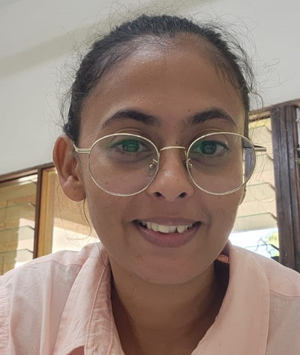icipe Governing Council Awards 2023
During its Annual General Meeting held on 31st October 2023, the icipe Governing Council, which consists of globally renowned scientists, honoured six outstanding postgraduate scholars, currently undertaking their research at the Centre.
Best published science paper by an icipe scholar


Komi Mensah Agboka (PhD, Togo)
icipe mentors: Drs. Henri E. Z. Tonnang and Elfatih M. Abdel-Rahman
Paper: Agboka, K. M., Tonnang, Z. E. H., Abdel-Rahman, E. M., Kimathi, E., Mutanga, O., Odindi, J., Niassy, S., Mohamed, S. A. and Ekesi, S. 2022. A systematic methodological approach to estimate the impacts of a classical biological control agent’s dispersal at landscape: application to fruit fly Bactrocera dorsalis and its endoparasitoid Fopius arisanus. Biological Control, 105053. https://doi.org/10.1016/j.biocontrol.2022.105053 (IF 4.2).
Contribution to science: In our research, we explored the potent nexus of classical biological control using advanced artificial intelligence to promote sustainable measures against the oriental fruit fly, B. dorsalis, in Africa's agricultural canvas. Under the esteemed guidance of the International Centre of Insect Physiology and Ecology (icipe) scientists, our research unveiled the koinobiont endoparasitoid, F. arisanus, as an effective strategic countermeasure against this pest. Our novel methodology, however, lies beyond mere biological control; it resides in our innovative strategy of quantifying the impact of this intervention. Utilizing sophisticated AI models, reminiscent of potent tools like computer intelligence, our study provides an in-depth spatial-temporal analysis of the spread and subsequent impacts of F. arisanus. The intricate blend of cellular automata (CA) with ecological niche models, is a testament to our forward-thinking approach. Our published findings in the high-impact factor journal Biological Control serve as a clarion call to the agricultural community, emphasizing a shift towards sustainable, solutions for pest management. Beyond the statistics lies a narrative of real-world transformation: hundreds of thousands of households reaping the rewards of our interventions, marking a significant reduction in reliance on synthetic pesticides. In summation, our research isn't merely a scientific study; it's a paradigm shift. Through the perfect amalgamation of biology and cutting-edge AI, our findings are set to recalibrate the benchmarks of Integrated Pest Management (IPM) strategies, promoting a more sustainable, informed, and holistic approach to agricultural challenges.
Funding: This work received financial support from the International Development Research Centre (IDRC) and the Australian Centre for International Agricultural Research (ACIAR) for the project “Alien invasive fruit flies in Southern Africa: Implementation of a sustainable IPM programme to combat their menaces (grant number 109040)”; and the German Federal Ministry for Economic Cooperation and Development (BMZ), commissioned by the Deutsche Gesellschaft für Internationale Zusammenarbeit (GIZ) through the Fund International Agricultural Research (FIA), grant number: 18.7860.2-001.00. In addition, the authors gratefully acknowledge the financial support for this research from the following organizations and agencies the Swedish International Development Cooperation Agency (Sida); the Swiss Agency for Development and Cooperation (SDC); the Australian Centre for International Agricultural Research (ACIAR); the Norwegian Agency for Development Cooperation (Norad); the Federal Democratic Republic of Ethiopia; and the Government of the Republic of Kenya. The views expressed herein do not necessarily reflect the official opinion of the donors.
University: The scholar graduated from the University of KwaZulu-Natal, South Africa.


Rehemah Gwokyalya (PhD, Uganda)
icipe mentors: Dr Samira A. Mohamed, Jeremy K. Herren, and Shepard Ndlela
Paper: Gwokyalya R, Weldon WC, Herren KJ, Gichuhi J, Makhulu EE, Ndlela S, Mohamed AM (2023). Friend or Foe: Symbiotic Bacteria in Bactrocera dorsalis–Parasitoid Associations. Biology, 12(2), 274; https://doi.org/10.3390/biology12020274. (IF 4.2)
Contribution to science: The invasive fruit fly pest, Bactrocera dorsalis is a major challenge to horticultural production across the globe. For example, following its invasion, a conservative estimated loss of horticultural produce equating to USD 5.8 billion annually has been reported for sub-Saharan Africa. The use of parasitoids has been adopted as an eco-friendly tool to manage this pest. However, the success of parasitoid-oriented biological control is constrained by the number and performance of the released parasitoids, factors which are influenced by host-associated symbionts.
Our study has demonstrated for the first time that bacterial symbionts of B. dorsalis indeed influence parasitoid development and emergence as well as fitness. We showed that there are synergistic and antagonistic relationships between the parasitoids and the symbionts depending on the symbiont present in the host gut. The commensal gut symbiont L. lactis favored parasitoid development and emergence evidenced by the high adult parasitoid emergence rates. This symbiont-parasitoid synergy could be as a result of the suppression of the immune defenses of B. dorsalis by L. lactis. Contrarily, P. alcalifaciens hindered parasitoid development and emergence but improved parasitoid fitness.
The enhancement of parasitoid offspring fitness could be attributed to improved host quality by the symbionts via nutrient provisioning. By providing nutrients like lipids and proteins, symbionts contribute to the dietary requirements of their host and in turn to that of the developing parasitoid. It is, therefore, likely that the key mechanisms underpinning the synergistic action of L. lactis are host immune suppression and nutrient provisioning. These findings elucidate the role of symbionts as key drivers of host-parasitoid dynamics and shed light on role of host-microbe as well as host-parasitoid interactions in the eco-physiological functioning of the pestiferous fruit fly, B. dorsalis. We suggest that L. lactiscan be used as a probiotic in mass rearing programs of parasitoids used in classical biological control of B. dorsalis. This will increase the efficacy of these parasitoids and contribute to sustainable management of this pest, thereby improving the quality and quantity of horticultural produce.
Funding: This work received financial support from the International Development Research Centre (IDRC) and the Australian Centre for International Agricultural Research (ACIAR) grant number 109040; the Norwegian Agency for Development Cooperation (NORAD), the Section for Research, Innovation, and Higher Education grant number RAF-3058 KEN-18/0005; the Swedish International Development Cooperation Agency (Sida); the Swiss Agency for Development and Cooperation (SDC); the Australian Centre for International Agricultural Research (ACIAR); the Norwegian Agency for Development Cooperation (Norad); the Federal Democratic Republic of Ethiopia; and the Government of the Republic of Kenya. The views expressed herein do not necessarily reflect the official opinion of the donors.
University: The scholar is registered at the University of Pretoria, South Africa.


Emmanuel Peter (PhD, Nigeria)
icipe mentors: Dr Amanuel Tamiru, Prof Baldwyn Torto and Dr Subramanian Sevgan
Paper: Peter E, Tamiru A, Subramanian S, Dubois T, Kelemu S, Kruger K, Torto B and Yusuf A (2023). Companion crops alter olfactory responses of the fall armyworm (Spodoptera frugiperda) and its larval endoparasitoid (Cotesia icipe). Chem. Biol. Technol. Agric. 10:61. https://doi.org/10.1186/s40538-023-00415-6 (IF 6.6)
Contribution to science: The fall armyworm (FAW), Spodoptera frugiperda (J.E. Smith) (Lepidoptera: Noctuidae), is a generalist and invasive pest that poses a significant threat to maize production in Africa, with yield losses of 20-50%. Since its invasion to Africa in 2016, the FAW has become a serious threat to food security in the continent. Conventional pest control measures have heavily relied on synthetic pesticides leading to adverse environmental and health impacts. Hence, there is an urgent need to develop an eco-friendly and more sustainable alternative to chemical control. Intercropping is a practice used by smallholder farmers in Africa for centuries and has demonstrated various benefits including reducing insect pest infestation. However, the scientific basis underlying the reduced incidence of FAW in these cropping systems has not been fully elucidated and cases of contrasting findings have been reported.
Oviposition behaviour in FAW precedes herbivory, making it the primary encounter between host plants and herbivores. Inhibition of this behaviour can reduce pest population and help to keep the damage below the economic threshold. In this study, we demonstrated that significantly fewer eggs were laid on maize in the presence of companion plants except cassava. Our wind tunnel study further elucidates the relationship between plant-emitted volatiles and behavioural activities of FAW such as moth visits (number of approaches), landing distance and the number of eggs laid. We also found that FAW larval endoparasitoid Cotesia icipe was attractedto volatiles from the companion plants when tested individually and/or in combination with maize. Chemical analysis identified several potential oviposition behaviour-modifying compounds including (Z)-3-hexenyl acetate, (E)-β-ocimene, (E)-4,8-dimethyl-1,3,7-nonatriene, (E)-β-caryophyllene, camphor, methyl salicylate and (E, E)-4,8,12-trimethyl-1,3,7,11-tridecatetraene in the headspace collection of companion plant volatiles. The results of this scientific research will not only provide evidence supporting diversified maize cropping system's role in reducing FAW damage by repelling the pest and recruiting its natural enemies but also pave a way for the development of an effective and ecologically sustainable FAW management strategy.
Funding: This research was supported by EU-FAW IPM project, grant number FOOD/2018/402-634 through the International Centre of Insect Physiology and Ecology (icipe).. We gratefully acknowledge icipe core funding provided by the Swedish International Development Cooperation Agency (Sida); the Swiss Agency for Development and Cooperation (SDC); the Australian Centre for International Agricultural Research (ACIAR); the Norwegian Agency for Development Cooperation (Norad), the Federal Democratic Republic of Ethiopia; and the Government of the Republic of Kenya. The views expressed herein do not necessarily reflect the official opinion of the donors.
University: The scholar is registered at the University of Pretoria, South Africa.
Best science poster by an icipe scholar

Abneel Matharu (PhD, Kenya)
icipe mentor: Dr. Ulrike Fillinger
Poster: Efficacy of Pyriproxyfen in control of off-host stages of Tunga penetrans
Contribution to science: Tunga penetrans is the cause of a severely neglected parasitic skin disease (tungiasis) in the tropics. Regardless of treatment, re-infection occurs almost immediately due to the environmental off-host stages hence the need to identify targets for parasite control for disease prevention. Insect growth regulators have the ability to mimic a natural hormone in insects and disrupt their growth. Pyriproxyfen (an insect growth regulator) is used widely in high income countries for parasite control in pets and livestock and is available in low-income countries for plant pest control. This study assessed the efficacy of pyriproxyfen against Tunga off-host stages in the laboratory and its impact on disease outcome in a randomised field trial.
We implemented dose-response tests with four concentrations of pyriproxyfen to investigate their impact on development and adult emergence. The recommended concentration of pyriproxyfen was then tested in a randomised control trial of 34 tungiasis infested households in each arm 1) PPF, 2) Water and 3) Untreated controls. Applications were done weekly for 4 weeks and the disease outcomes assessed on the 5th week.
From our results, unexposed controls in laboratory bioassays resulted in 100% of all larvae successfully developing into adults. Pyriproxyfen prevented 100% pupation in as low concentrations as 0.0075 parts per million active ingredients. Whereas, during the field trial, prevalence of infection with live fleas among the household members reduced by 68% in the PPF arm (OR 0.32, 95% CI 0.24-0.42; <0.001) and by 38% for water arm (OR 0.62, 95% CI 0.52-0.74; <0.001) in comparison to the baseline and untreated control. Similarly, the intensity of infection reduced by 80% in the PPF arm and by 40% in the water arm.
We conclude that weekly spraying of a very low-dose pyriproxyfen solution results in a relatively fast clearance of disease. The water impact was surprising but is likely associated with unfavourable larvae development conditions after repeated application.
Funding: The authors gratefully acknowledge the financial support for this research by the following organizations and agencies: the German Research Foundation (DFG) through the project ‘Tungiasis in East Africa – an interdisciplinary approach to understand the interactions between parasite and hosts (project number 405027164; KR 2245/7-1); the Swedish International Development Cooperation Agency (Sida); the Swiss Agency for Development and Cooperation (SDC); the Australian Centre for International Agricultural Research (ACIAR); the Norwegian Agency for Development Cooperation (Norad); the Federal Democratic Republic of Ethiopia; and the Government of the Republic of Kenya. The views expressed herein do not necessarily reflect the official opinion of the donors.
University: The scholar is registered at the Freie Universität Berlin, Germany.


Emmanuel Peter (PhD, Nigeria)
icipe mentors: Dr Amanuel Tamiru, Prof Baldwyn Torto and Dr Subramanian Sevgan (icipe)
Poster Title: Fall armyworm larval parasitoid, Coccygidium luteum, exploits cues from companion plants to locate its host.
Contribution to science: The fall armyworm (FAW), Spodoptera frugiperda, seriously endangers African food security, causing 20-50% yield reductions. Current chemical pesticide-heavy approaches may cause adverse environmental and health issues. Hence, developing an eco-friendly and sustainable alternative to chemical control is vital. Crop diversification has been proposed to reduce FAW infestation; however, the underpinning chemical ecology mechanisms have not been adequately studied. In this study, we hypothesized that odours released by companion crops in maize-based intercropping systems would enhance parasitoid foraging efficiency and improve their ecological fitness. To test this hypothesis, we investigated the response of the female FAW larval parasitoid, Coccygidium luteum, to FAW-induced maize and constitutive companion plant volatiles in a four-arm olfactometer. In dual treatment assays, C. luteum was attractedto volatiles from FAW larval-damaged maize and healthy companion plants (sweet potato, beans and groundnut) when compared to solvent control. Interestingly, we found that the FAW larval parasitoid was still significantly attracted to healthy companion plants (sweet potato, beans and groundnut) volatiles in the presence of FAW larval-damaged maize volatiles in a multiple-treatment assay. Chemical (GC-MS) and electrophysiology (EAG) analysis detected several potential behaviour-modifying compounds including (E)-2-hexenal, (Z)-3-hexen-1-ol, (Z)-3-hexenyl acetate, (E)-β-ocimene, (E)-4,8-dimethyl-1,3,7-nonatriene, (E)-β-caryophyllene, (E)-β-farnesene, (E)-nerolidol and (E, E)-4,8,12-trimethyl-1,3,7,11-tridecatetraene in the headspace collection of test plant volatiles influencing C. luteum behaviour. In summary, our results provide evidence that constitutive companion plants’ volatile can play a significant role as host location cues to herbivores’ natural enemies. These findings will contribute to designing ecologically sustainable FAW management strategies and enhancing biological control by providing further insights into the plant-herbivore-natural enemies tri-trophic interactions.
Funding: This research was supported by EU-FAW IPM project, grant number FOOD/2018/402-634 through the International Centre of Insect Physiology and Ecology (icipe). We gratefully acknowledge icipe core funding provided by the Swedish International Development Cooperation Agency (Sida); the Swiss Agency for Development and Cooperation (SDC); the Australian Centre for International Agricultural Research (ACIAR); the Norwegian Agency for Development Cooperation (Norad); the Federal Democratic Republic of Ethiopia; and the Government of the Republic of Kenya. The views expressed herein do not necessarily reflect the official opinion of the donors.
University: The scholar is registered at the University of Pretoria, South Africa.


Anne Wairimu (MSc., Kenya)
icipe Mentor: Dr. Jeremy Herren
Poster title: Investigation of a Microsporidia MB protective phenotype against entomopathogenic fungi in the malaria vector, Anopheles arabiensis
Contribution to science: Microsporidia MB is a maternally transmitted endosymbiont that has been reported to block the transmission of Plasmodium falciparum in Anopheles arabiensis. Entomopathogenic fungi play a vital role as biocontrol agents of mosquito vectors. The recent discovery of Anopheles symbiont, Microsporidia MB has provided new avenues for complementary tools to control malaria. However, the possibility of its protective phenotype to interfere with pathogenic biological control agents is yet to be addressed. In addition, pathogens that have been introduced artificially can drive the selection of symbiotic variants that promote host resistance and/or the selection against symbionts that increase host susceptibility to infections, which can lead to fixation of defensive variant. This study investigated the mechanistic basis of Microsporidia MB protective phenotype when mosquitoes harbouring Microsporidia MB are exposed to a commonly used biopesticide for management of ticks, which is also known to infect An. Arabiensis mosquitoes. Mosquitoes with Microsporidia MB and uninfected controls were exposed to a standard dosage of spores of the entomopathogenic fungus, Metarhizium anisopliae (strain ICIPE 7). We found that mosquitoes with Microsporidia MB survived slightly longer than those without the symbiont. Our results suggest that Microsporidia MB confers an antifungal immunity through upregulation of detoxifying enzyme, glutathione S transferase which promotes longevity. Upregulation of Serine protease and downregulation of serpins activated the melanization process. Apoptosis genes were also upregulated to potentially eliminate the already damaged cells by the fungi. These findings are a base line to decipher the intricate mechanisms by which Microsporidia MB confers protection against pathogens within tractable mosquito system which will be harnessed in developing a sustainable and long-term Microsporidia MB dissemination strategy.
Funding: This work is supported by the Wellcome Trust. We gratefully acknowledge all the icipe core funding provided by the Swedish International Development Cooperation Agency (Sida); the Swiss Agency for Development and Cooperation (SDC); the Australian Centre for International Agricultural Research (ACIAR); the Norwegian Agency for Development Cooperation (Norad); the Federal Democratic Republic of Ethiopia; and the Government of the Republic of Kenya. The views expressed herein do not necessarily reflect the official opinion of the donors.
University: The scholar is registered at the University of Glasgow, United Kingdom.

